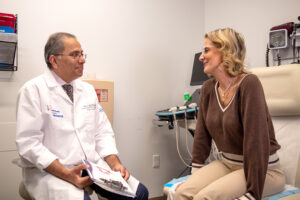Seniors have many options for fixing gaps in smiles caused by damaged, decayed, or missing teeth. Two popular choices are partial dentures and bridges. Each device can restore the look and function of your teeth, increasing everyday comfort and boosting self-confidence. However, they differ in important respects as well. This article explores both devices’ aesthetic and functional benefits, then compares each across a few factors.
Aesthetic benefits of partial dentures and bridges
Partial dentures and bridges restore your smile’s appearance in several ways:
Tooth shape and size matching
Both bridges and partial dentures are shaped and sized to resemble the teeth they replace and look like surrounding teeth. This can make the devices appear like natural teeth, blending in seamlessly with the rest of your teeth and restoring your smile’s appearance.
Color matching
Bridges and partial dentures each can be made of porcelain, a white ceramic substance, to closely resemble the color of your regular teeth. Furthermore, lab technicians can add shading and tints to the devices to further match the surrounding teeth. For example, if surrounding teeth have a slight yellow tinge, the techs can adjust your device accordingly.
Tooth alignment maintenance
Missing teeth can cause other teeth to shift in place. It can also lead to jawbone loss, affecting your facial appearance. Partial dentures and bridges prevent your teeth from shifting in your mouth. This mitigates the potential for your teeth to become crooked and prevents jawbone loss from occurring.
Functional benefits of partial dentures and bridges
Partial dentures and bridges make your smile look better, but the main benefits are functional:
Restored chewing and speaking
Eating and speaking are more difficult and uncomfortable with missing or damaged teeth. Digestion can worsen as well since you can’t chew food as well. Partial dentures and bridges replace those damaged or missing teeth, restoring your ability to eat and speak comfortably.
Protection against other future issues
As mentioned, missing teeth can make other teeth shift and misalign your teeth. Misaligned teeth complicate eating, increase tooth wear, trap bacteria, and cause pain. Plus, missing teeth remove stimulation for the underlying jawbone, causing that jawbone to weaken and deteriorate over time. Partial dentures and bridges restore a tooth-like structure to the missing area. This prevents other teeth from moving and stimulates the jawbone again, preventing jawbone loss.
Easy care
Caring for partial dentures and bridges is fairly easy. Bridges require little else beyond regular oral hygiene habits, which include twice-daily brushing and once-daily flossing and rinsing. Partial dentures are the same if they are permanent, meaning non-removable. If the dentures are removable, you may need to do a bit of extra cleaning and apply adhesives for them to stay snug in the mouth.
If you check out this dentist in Pulaski TN, they’ll also tell you that regular dental checkups are essential to ensure that both partial dentures and bridges remain in good condition and fit properly. Your dentist can spot signs of wear, adjust the fit if needed, and check for any issues that may affect your overall oral health.
Partial dentures vs. bridges: Which is better?
Partial dentures and bridges vary across several factors:
- Comfort: Bridges may be more comfortable than removable partial dentures since the latter may slip if not properly secured.
- Durability: Partial dentures may last longer than bridges.
- Process: Partial denture procedures are generally less invasive than bridges. Plus, same-day dentures can help you replace missing teeth much faster.
- Cost: Generally, removable partial dentures cost less than dental bridges, but the price can vary across many factors.
- Maintenance: Dentures may require a little more maintenance if removable.
- Removability: Bridges are never removable. Dentures are available in removable form.
The bottom line
Partial dentures and bridges can each restore your smile’s look and function. They prevent teeth from shifting, preserve your jawbone, bring back your ability to eat and speak, and guard against future issues. Both devices can do the job well, but the best depends on your circumstances. If you need restorative dentistry, speak with your dentist to learn which procedure may suit your situation best.






